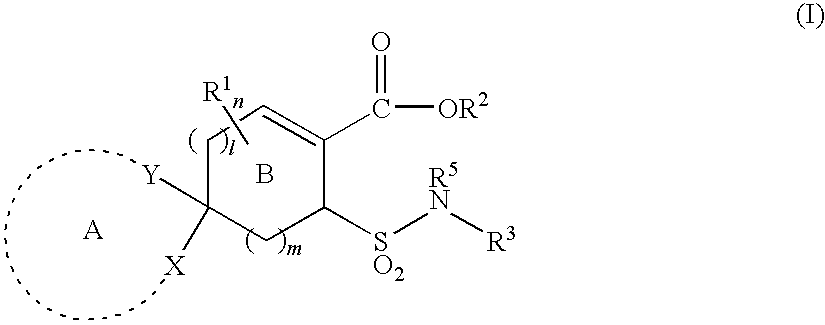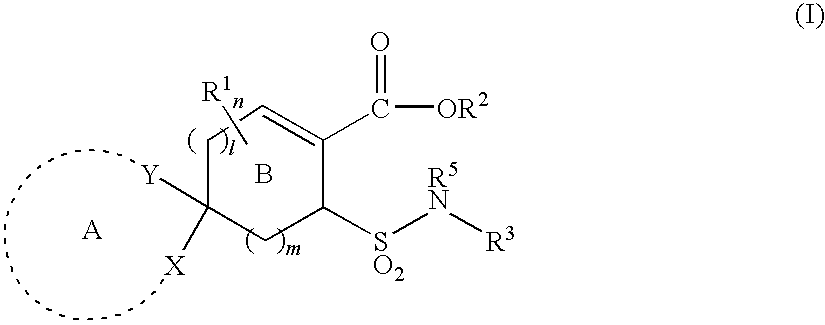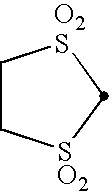Substituted cycloalkene derivative
a cycloalkene derivative and substitute technology, applied in the field of new compounds, can solve the problems of difficult prevention and treatment of diseases, large number of patients, etc., and achieve the effect of suppressing excess generation and excellent activity to suppress intracellular signal transduction
- Summary
- Abstract
- Description
- Claims
- Application Information
AI Technical Summary
Benefits of technology
Problems solved by technology
Method used
Image
Examples
example 1
Ethyl 8-[N-(2-chloro-4-fluorophenyl)sulfamoyl]-1,4-dioxaspiro[4.5]dec-6-ene-7-carboxylate (Exemplified compound No. 1-364
[0417]
(1a) Ethyl 8-acetylsulfanyl-1,4-dioxaspiro[4.5]dec-7-ene-7-carboxylate
[0418]19.97 g (55.4 mmol) of ethyl 8-trifluoromethanesulfonyloxy-1,4-dioxaspiro[4.5]dec-7-ene-7-carboxylate [compound described as compound 6 in Tetrahedron Letter, Vol. 39, pp. 6139-6142 (1998)] was dissolved in 200 ml of dimethylformamide, and 9.50 g (83.1 mmol) of potassium thioacetate was added thereto with stirring under ice-cooling, followed by stirring at room temperature for 91 hours. To the reaction solution was added ice water and the mixture was extracted with ethyl acetate. The organic layer was washed with water and dried over anhydrous magnesium sulfate, followed by concentration under reduced pressure. The residue was subjected to silica gel column chromatography (solvent; hexane:ethyl acetate=17:3) to give 7.15 g of the title compound as a pale brown oil (yield: 45%).
[0419]...
example 2
Ethyl 8-(N-phenylsulfamoyl)-1,4-dioxaspiro[4.5]dec-6-ene-7-carboxylate (Exemplified compound No. 1-12)
[0431]
[0432]Following the process described in Example (1d), aniline was used in place of 2-chloro-4-fluoroaniline to give the title compound as an amorphous substance (yield: 81%).
[0433]1H-NMR spectrum (400 MHz, CDCl3) δ ppm:
[0434]7.37-7.31 (4H, m), 7.21-7.15 (1H, m), 6.95 (1H, s), 6.85-6.87 (1H, m), 4.30-4.20 (3H, m), 4.13-4.01 (3H, m), 3.94-3.88 (1H, m), 2.48-2.41 (1H, m), 2.31 (1H, td, J=14 Hz, 3 Hz), 2.10-2.00 (1H, m), 1.86-1.80 (1H, m), 1.31 (3H, t, J=7 Hz).
example 3
Ethyl 8-[N-(2-butylphenyl)sulfamoyl]-1,4-dioxaspiro[4.5]dec-6-ene-7-carboxylate (exemplified compound No. 1-540)
[0435]
[0436]Following the process described in Example (1d), 2-butylaniline was used in place of 2-chloro-4-fluoroaniline to give the title compound as a colorless oil (56% yield).
[0437]1H-NMR spectrum (400 MHz, CDCl3) δ ppm:
[0438]7.55-7.52 (1H, m), 7.22-7.17 (2H, m), 7.13-7.08 (1H, m), 6.85-6.84 (1H, m), 6.63 (1H, s), 4.47-4.44 (1H, m), 4.25-4.02 (5H, m), 3.95-3.89 (1H, m), 2.71-2.62 (2H, m), 2.54-2.38 (2H, m), 2.19-2.09 (1H, m), 1.86-1.81 (1H, m), 1.62-1.53 (2H, m), 1.45-1.34 (2H, m), 1.26 (3H, t, J=7 Hz), 0.95 (3H, t, J=7 Hz).
PUM
| Property | Measurement | Unit |
|---|---|---|
| Temperature | aaaaa | aaaaa |
| Fraction | aaaaa | aaaaa |
| Fraction | aaaaa | aaaaa |
Abstract
Description
Claims
Application Information
 Login to View More
Login to View More - R&D
- Intellectual Property
- Life Sciences
- Materials
- Tech Scout
- Unparalleled Data Quality
- Higher Quality Content
- 60% Fewer Hallucinations
Browse by: Latest US Patents, China's latest patents, Technical Efficacy Thesaurus, Application Domain, Technology Topic, Popular Technical Reports.
© 2025 PatSnap. All rights reserved.Legal|Privacy policy|Modern Slavery Act Transparency Statement|Sitemap|About US| Contact US: help@patsnap.com



